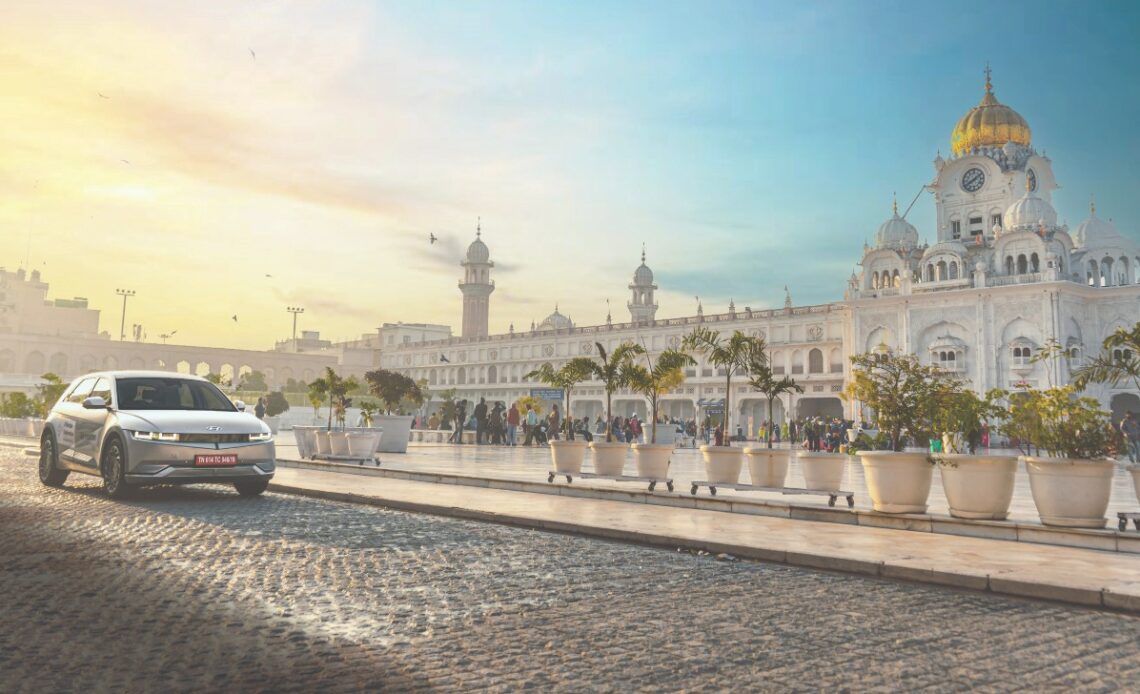
HYUNDAI AS A MANUFACTURER HAS BEEN IN INDIA FOR NEARLY AS LONG AS I’VE BEEN ON THIS PLANET.
A whopping 27 years have passed since this South Korean manufacturer first arrived at our shores. The Santro will forever be etched into my memory as the first car that Hyundai launched in India and the first car my family brought home. It was the car I had all my road trips in growing up and the car that introduced me to the art of driving. After 27 years of mobilising our country and its families, Hyundai has finally reached a point where it is now viewed as not the cheaper alternative but, the better alternative. Hyundai now makes vehicles that range from sub 10 lakhs to ones that exceed 30 lakhs. With each passing year, the brand slowly grew with each step to be recognised as a more premium brand and after all these years, that time has finally arrived.
The IONIQ 5 marks a milestone in Hyundai India’s book not only because it’s their first vehicle to be built on a dedicated EV architecture but also because it’s Hyundai’s most premium offering in its Indian catalogue by far. So for the launch of such a significant vehicle, why not make the review milestone worthy? What better way to do that than a road trip? And not just any road trip but one that would span throughout the country while setting a brand-new record.
Well, Hyundai loved the idea too, so on a cold winter morning, we picked up the brand new IONIQ 5 from the HMI headquarters and were ready to go. Given this launch and monumental journey, we visited several monuments. These aren’t your regular monuments but are known as the seven wonders of India. The first of our wonders is too well-known to need an introduction.
630KM – Amritsar, Punjab
So without any delay, we set off for our first destination, the Golden Temple in Amritsar; this monument needs little to no introduction. Built-in 1589, the Golden Temple is known for its beauty and religious significance to Sikhism. Our journey to Amritsar would be about 500 kms from Delhi and would be a perfect way to test the claimed range of this vehicle. Hyundai claims that the IONIQ 5 can do about 630 kms in one full charge, but to be safer, we intended to make a quick stop to juice up on the way. After all, we had a record to set, and our journey had just begun.
The drive to the Golden Temple was surprisingly relaxing, and I was amazed by how comfortable the IONIQ 5 felt. This was unlike any Hyundai I’d ever driven and felt like a cut above. The road to the Amritsar was pretty well paved, and we didn’t get an excellent chance to see just how well it would do on our typical Indian roads, so to say, but alas, our journey had only just begun.
They say that a visit to the Golden Temple replenishes one’s soul. Well, mine felt replenished, basking in the serenity of this temple. With my blessings in check, I continued towards our next destination, which too requires little to no introduction and is globally known.
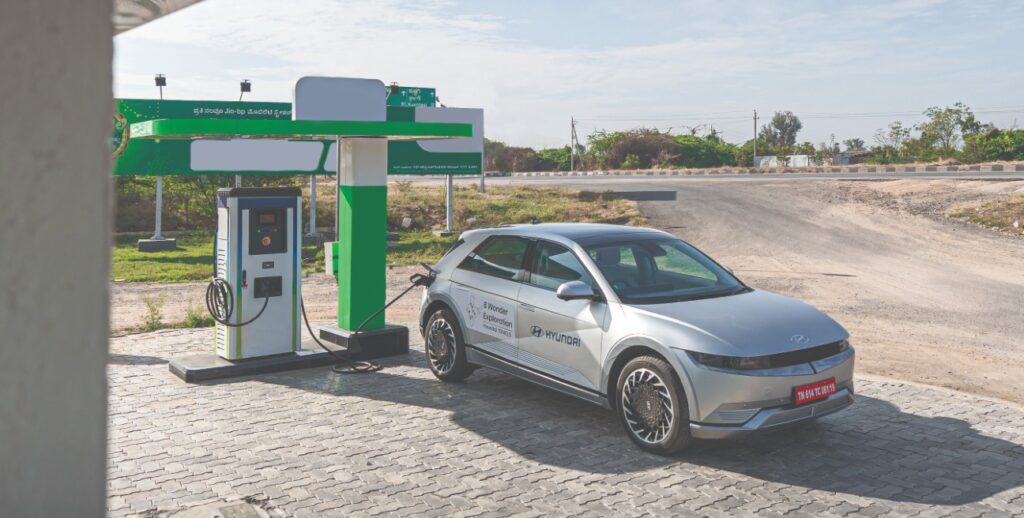
1,310KM – Agra, Uttar Pradesh
Known as the symbol of love and found in Agra, the Taj Mahal is a renowned monument in India and a wonder to the world. It’s renowned for its mesmerising architecture and timeless beauty. Its design still influences modern-day architecture students with its exquisite details and elaborate carvings. The distance to Agra from Amritsar was about 700 kms, so we’d need one quick stop to juice up on the way, and we were good to go. Finding chargers so far was easy since we were around significant cities and civilizations.

Still, once we were past Agra, we would be venturing into uncharted territory, and that sort of uncertainty can be scary, especially when you’re aiming to set a record. Nevertheless, our spirits were high, and we had faith in ourselves and the IONIQ 5 to come through.
As before, our journey mainly comprised well-paved highways as we quickly covered ground and made it to Agra, where the roads were narrow, and the potholes were abundant. There is something extraordinary about the city of Agra, as parts of it seem frozen in time. With its congested busy streets and rich history, a lovely vibe in the air made me feel like a tourist in my country.
Anyway, we finally found an excellent spot to observe the Taj Mahal from afar and what a spectacle it is to behold. It’s a lot bigger than you’d imagine and looks magnificent even from afar. This would be an excellent opportunity to admire my ride and talk about the styling of the IONIQ 5.
If you have not noticed, let me address the elephant in the room. The IONIQ 5’s styling is polarising, to say the least, but I mean it in the best way possible. Its intriguing design managed to turn heads nearly everywhere we went, and each time we parked the car, a crowd gathered within moments. The IONIQ 5 takes inspiration from the Hyundai Pony, launched in 1975. It was a handsome rear-wheel drive vehicle with a design language ahead of its time.
The IONIQ 5 takes inspiration from the Pony and manages to blend designs from the past and the future. The IONIQ 5 looks retro, to say the least, but in the most cyberpunk way possible. Its sharp and clean lines define it, and the smoked headlamp draws you in with its iconic parametric pixel design that manages to entice and illuminates the front of the IONIQ 5.
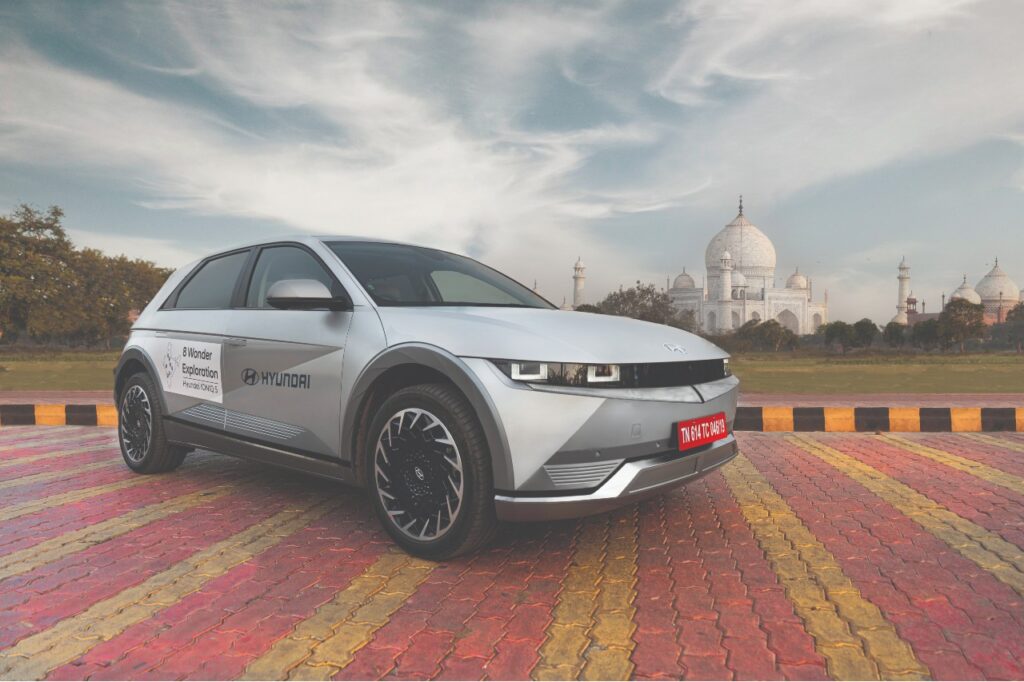
In this shade of matte silver, the IONIQ 5 looks especially angular and cutting since this shade further accentuates its lines. I was smitten with the design from the moment I saw it and grew increasingly fond of it the more time I spent with it. The front bumper integrates the active air flap system, aiding aerodynamics and cooling. I found the vent opening only at lower speeds or when standing still to cool the batteries, but they remain closed for the most part.
Coming to the side of the IONIQ 5, the angular lines continue and feature a Z-shaped character line, making the IONIQ 5 look athletic even when stationary. The 20-inch wheels on the IONIQ 5 are one of the sexiest wheels I’ve ever seen on any vehicle and the best I’ve ever seen on a Hyundai. They, too, follow a parametric pixel design and look stunning in person. They may taste for some, but I loved these wheels.
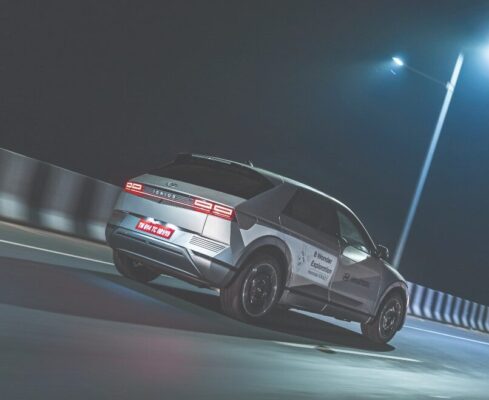
The door handles, too, remain flush and pop out every time you’re in the proximity of the vehicle, which only further adds to how clean the overall design is. Photos don’t justify how long and wide the IONIQ 5 looks in person. Coming to the rear of the IONIQ 5 and the parametric pixel design continues in the rear. The taillights look stunning both when they’re on and not. Despite being covered in lines, the vehicle looks relatively clean, all a testament to the shade and how well the car’s geometry plays with these lines. The rear three-quarter is by far, my favourite angle for the IONIQ 5, and I’m sure you’d also have a favourite once you see it in person. The rear spoiler is rather neatly integrated into the roof and conceals a brake light into the spoiler.
I have little to no gripes with the design of the IONIQ 5, and beauty may lie in the eye of the beholder, but I cannot deny just how beautiful this Hyundai looks. Now that I’m done admiring these two wonders of engineering and architecture, I head to my next destination, Madhya Pradesh, in Khajuraho. This is where our journey into uncharted territory began, where the internet no longer showed us any availability of reliable chargers. Worst-case scenario, we were willing to sacrifice some precious time and rely on an AC charger which could take over a day or even more depending on the charge we had left.
So with that in mind, we set off on the Agra-Lucknow Expressway, a freshly laid piece of tarmac that was as well paved as they come and primarily desolate since we started at the crack of dawn. This would be a great place to test the highway performance and ride quality of the IONIQ 5. Right off the bat, I can tell you that the IONIQ 5 rides like no other Hyundai that has come before it. It’s soft, supple, and rides smoothly, especially following the speed limit.
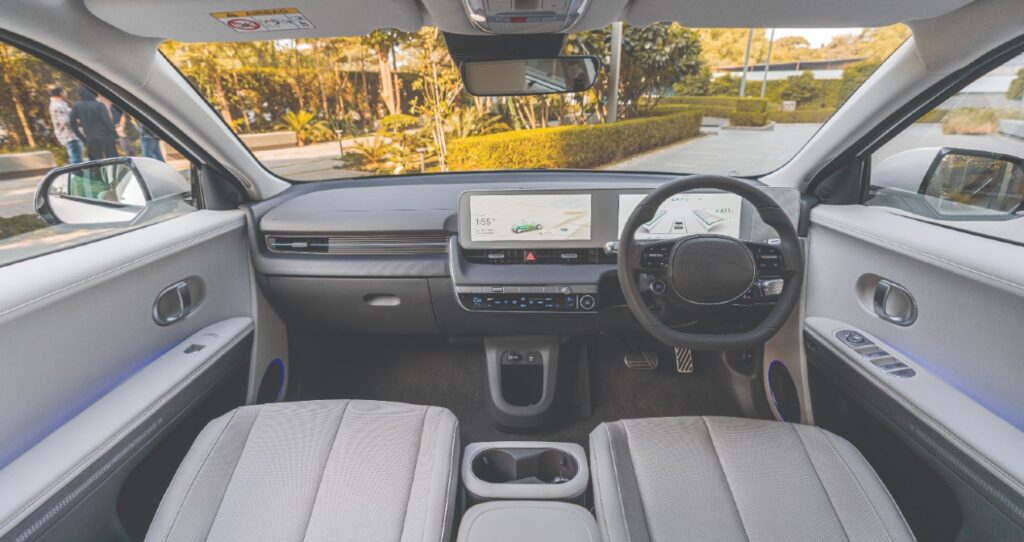
As smooth as our roads are, one eventually encounters a bumpy patch occasionally, where the IONIQ 5 needs to catch up. At lower speeds, it handles bumps well enough, but as soon as you go a bit faster, the suspension seems too busy under you and feels like it’s working overtime, as the IONIQ 5 tends to lose its composure.
Infact, if you go over a speed breaker too fast or not slow enough, the rear suspension tends to dive as it goes over the bump. Hyundai could have done a better job calibrating the rebound damping of the rear suspension because it seems a tad too soft for our Indian roads. Granted, it brings comfort when on busy streets, but I would have preferred a better balance between handling and comfort.
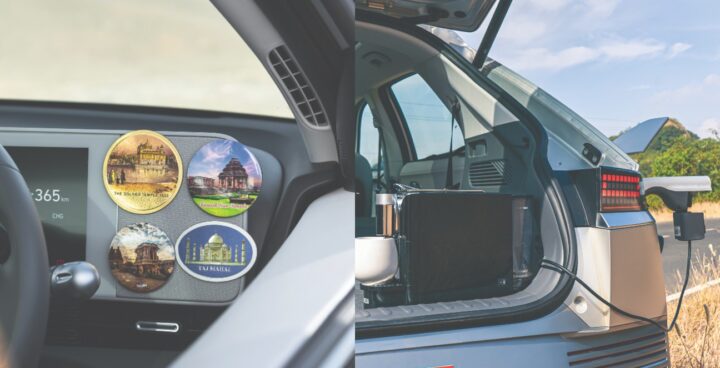
We managed to make it to the city of Kanpur, where to our amusement, not a single charger seemed to be working, and the ones that did would either trip or stop working due to the power cuts the city was facing. To our surprise, Hyundai doesn’t have any chargers at its own dealerships, and if you’re a Hyundai owner, know that you will essentially be relying on chargers from Tata, MG, BMW and Audi. Buying a premium Hyundai product exceeds the vehicle.
This could be a make-it-or-break-it factor. Knowing that you share the workshop floor with vehicles that are more mass-market than premium could sour the deal for some potential buyers, and this got me thinking about how Hyundai needs to improve its overall quality appeal because selling a premium product is more than just fancy tech and high performance but more on that later.
1,920KM – Khajuraho, Madhya Pradesh
After somehow charging the vehicle in Kanpur, we were off to Khajuraho, where technology was limited, and so was infrastructure. Khajuraho is a beautiful city in Madhya Pradesh known for its erotic art and detailed temple architecture. Finding a charger here was not going to be possible, and we had to rely on using a wall-mounted socket to charge the vehicle, which meant we’d had to spend the next three days charging up the vehicle since the speed was a mere 1 KW per hour. This gave us plenty of time to plan our next few stops and do some sightseeing around the beautiful temples of Khajuraho. This would be a good time to talk about the interiors of the IONIQ 5, which, unlike the temples in Khajuraho, took a more minimal approach to styling.
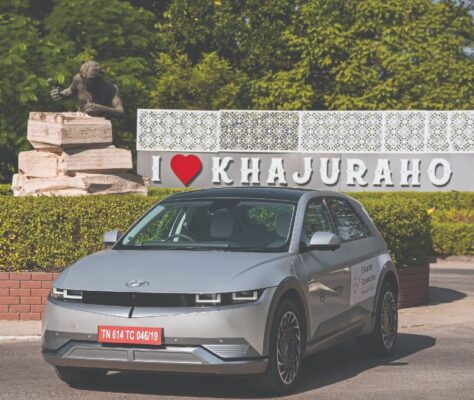 The interior of the IONIQ 5 is simple and clean. Hyundai has done away with most buttons which is a one-step forward and twostep back approach but more on that in a bit. So from the moment you step inside the cabin, you realise that there is ample space and thanks to the minimalistic approach, even the dashboard remains clutter-free.
The interior of the IONIQ 5 is simple and clean. Hyundai has done away with most buttons which is a one-step forward and twostep back approach but more on that in a bit. So from the moment you step inside the cabin, you realise that there is ample space and thanks to the minimalistic approach, even the dashboard remains clutter-free.
The cabin feels airy thanks to the excess space; the white interiors then further exaggerate the sense of space, making it feel even more spacious than it already is. Given how space conscious we Indians tend to be, the IONIQ 5 does a fantastic job of triggering that sensory experience. You’d never feel claustrophobia, even with all five seats occupied. You can not only control the recline and movement of all five seats but also move the entire central armrest and everything under it, which makes finding the right amount of space for your needs a pretty easy affair. I don’t know any other car in India that can showcase such a feat, and it genuinely makes the interior of this car feel unique and customisable to suit your needs.
The trade-off of the white interior is the obvious dust magnet it is. Even on dry summer days, dirtying these seats and leaving stains all over is fairly straightforward. If you’re an owner with OCD, you will have a tough time keeping that OCD in check with this white leather interior. Sure, knowing that all the materials inside the vehicle come from sustainably sourced methods boost one’s consciousness, but knowing the lack of durability in our conditions makes it a bit of a tedious affair.
The lack of buttons makes the dash seem clean, but at the cost of constantly having to distract yourself from accessing the most basic functions like ventilated seats. A simple button would have done the trick, but now you must pull over and navigate through a giant screen whenever you wish to turn on or off the ventilated seats in the IONIQ 5.
The passengers in the rear get heated seats for some reason, but not seats that can be ventilated, and this seems like a sore miss given that the majority of the country and the metropolitan cities tend to be on the hotter side of things than the cooler ones we’d hope for.
Another thing worth mentioning is the comfort of the seats; Hyundai has done a fantastic job designing the seats and their support. Not only do they recline so you can practically sleep in the car while waiting out the charging, but they’re also entirely customisable and let you pick the optimum driving position to suit your dimensions and preferences. However, I’d like the steering to be further adjusted, as you can only adjust the rake, not the steering wheel’s reach.
2,550KM – Nalanda, Bihar
Long story short, after three days of charging, we were finally ready to reach our next destination, Nalanda, in Bihar. The ruins of Nalanda are considered by historians to be the world’s first residential university and among the most important centres of learning in the ancient world. Unfortunately, it succumbed to war and was pillaged and burned down by the Khalji dynasty, and now all that’s left are its ruins and tales of its rich history. Like Khajuraho, Nalanda had little to no chargers to offer, so we decided to juice up the IONIQ 5 in Patna instead and head over to Nalanda. This would be an excellent opportunity to discuss the advanced safety systems and tech in the IONIQ 5.
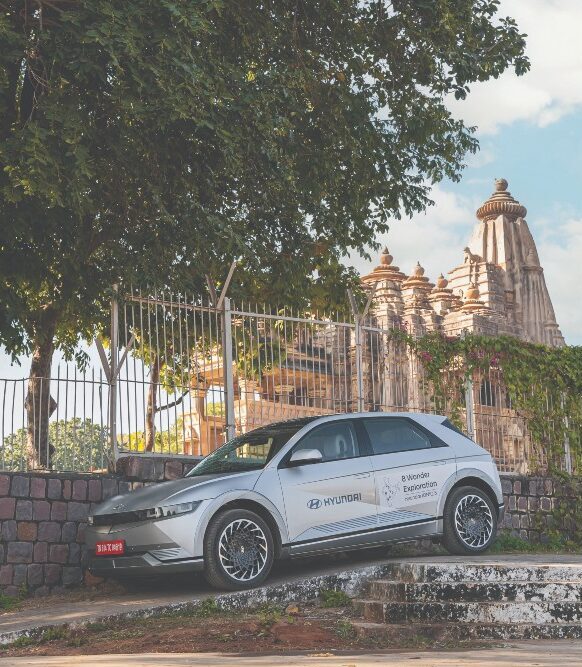 So Hyundai has equipped the IONIQ 5 with level 2 ADAS, which comes with upto 21 features, including forward and rear collision warnings, lane keep assist, a 360-degree camera, blind spot monitoring and safe exit assist, which essentially helps driving out of blind parking spots. These are just a few, as many more would take a while. As practical as all these features are, they can be too intrusive in the real world. For example, none of these features can be turned off except for lane keep assist; the rest remain running in the background.
So Hyundai has equipped the IONIQ 5 with level 2 ADAS, which comes with upto 21 features, including forward and rear collision warnings, lane keep assist, a 360-degree camera, blind spot monitoring and safe exit assist, which essentially helps driving out of blind parking spots. These are just a few, as many more would take a while. As practical as all these features are, they can be too intrusive in the real world. For example, none of these features can be turned off except for lane keep assist; the rest remain running in the background.
The safe exit assist is handy but can’t distinguish between a pedestrian approaching and a vehicle and treats both as the same. This means each time you’re backing out of the parking, it’ll aggressively slam on the brakes if it detects someone standing close to the rear. It may be in the name of safety, but over time, this can become quite annoying, especially when you factor in that this is in India and there are always people or vehicles present on the road at all times.
The intelligent cruise control can maintain a certain distance from the vehicles ahead of you, but it likes to remain two car lengths away even at its closest setting. Given how congested our streets usually are and how used to we are driving under such circumstances, the IONIQ 5, on the other hand, could be better versed with our streets. It tends to panic when a vehicle gets too close, which can be pretty unnerving for the driver and anyone behind you. I wish Hyundai provided the option to turn off some of these systems or let you further modulate to what degree they intrude.
 The lane keep assist works surprisingly well, and it even manages to detect lanes over some of our bad roads where the markings have either disappeared or are a mere blur. The sensors on the IONIQ 5 are top-notch; it’s just our infrastructure that has yet to grow to adapt to such order and still revels in its orderly chaos.
The lane keep assist works surprisingly well, and it even manages to detect lanes over some of our bad roads where the markings have either disappeared or are a mere blur. The sensors on the IONIQ 5 are top-notch; it’s just our infrastructure that has yet to grow to adapt to such order and still revels in its orderly chaos.
Our next destination was quite far, and we’d have to go all the way to the East Coast of India to the city of Bhubaneshwar. So our first stop was Ranchi, where we took a quick stop to charge and then headed straight for Jamshedpur. Finding a reliable charger again posed a challenge in Jamshedpur, which was a surprise given that Jamshedpur essentially is a giant Tata plant. Nevertheless, after a quick charge, we continued towards Bhubaneshwar, where we’d spend the night. The following day we rose before the sun and began our drive to Puri, a coastal town famous for its clean beaches and is a hop, skip and jump away from the famous Konark Sun Temple.
3,430KM – Puri, Odisha
Dedicated to the sun god Surya, the Konark Sun Temple is a staple of Kalingan architecture to impress the sun, which is the source of all our energy and at the centre of the solar system. Since we’re talking about a giant ball of nuclear fusion, it’ll seem ironic to talk about a vehicle that has ditched combustion. Solar is the future of powering all our electrical appliances, so we may address the electric motor and its prowess.
The Hyundai IONIQ 5 is powered by a liquid-cooled lithiumion battery with a capacity of 72.6 kWh, translating to about 220 bhp of power and 350 Nm of torque. These output figures may not sound all that impressive on paper, but if you think about it, you’d soon realise this has all its power available at all times, unlike an internal combustion motor. So despite weighing nearly 2 tons, the IONIQ 5 accelerates from 0 to 100kmph in under 7.5 seconds.
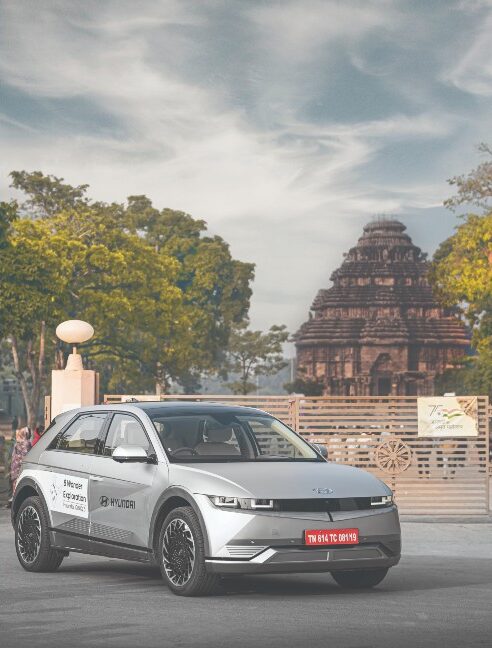
Its roll-on acceleration is even more impressive, making any overtake feel like a piece of cake. Sure, it’s no Volvo XC40 regarding sheer acceleration, but it offers an even better range. Most folks think the range is more important when buying an EV than outright performance. Plus, the IONIQ 5 feels fast enough to excite most drivers; the Volvo XC40, on the other hand, has now entered sports car territory.
The IONIQ 5 packs plenty of punch and, despite being a rear-wheel drive car, maintains traction at all times. Even when you’re intentionally trying to break traction, the safety systems will always be on guard and ready to spank you with traction each time you try to drift the vehicle or slide it around a corner.
The only time you can consistently break traction is when you’re on dirt, and even then, the IONIQ 5 will manage to reel itself in. If this is a testament to the IONIQ 5’s composure or a slap in the face to any EV enthusiast looking for that fun daily driver, that’s down to perspective. That being said, the IONIQ 5 drives like no other Hyundai before it and can be a ton of fun while also incredibly relaxing.
After having a lovely time at the coastal beaches of Puri, it was time we started our most extended leg, which was to be from Puri all the way to Hampi. This would have us cross three states on our journey to Hampi, which is located in the state of Karnataka. This nearly 1500 km journey would not only test dedication to our record but also test the IONIQ 5 as it would succumb to varying degrees of broken tarmac and dirt roads. As we traversed through open highways and busy city roads, we finally decided to halt in Visakhapatnam.
Finding chargers became much easier, and we were soon flying past Vijayawada and on our way to Hyderabad. Despite running on 20-inch wheels, the ground clearance and suspension rarely bottomed out. Eventually, I stopped babying the precious IONIQ and started driving it like a regular car. The IONIQ 5 is a rather easy-to-drive vehicle, and despite its odd dimensions and funky design, it is rather practical. I will talk more about it when we get to Hampi.
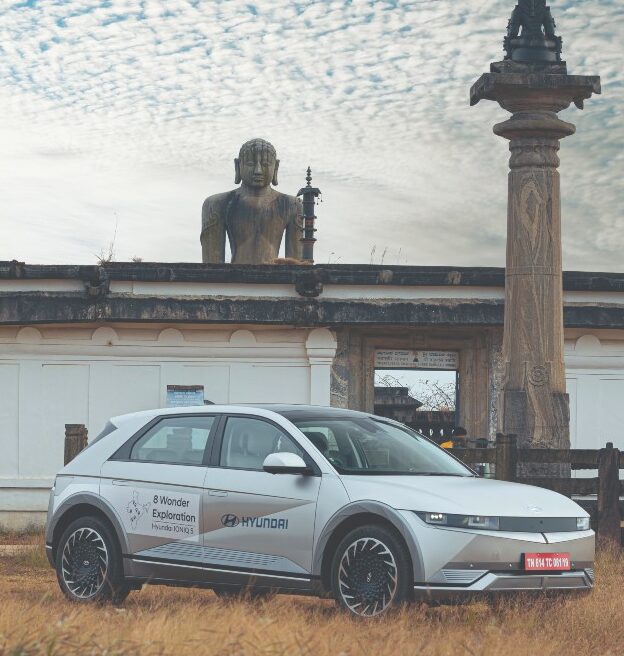 After our lengthy stint in Hyderabad and some much-needed rest, it was time to venture into the unknown again on our way to Hampi. After careful research, we discovered just one charger about 100 kms away from Hampi. Which means we’d have to make a gamble. We either head straight for Hampi and try and arrange a wall-mounted AC charger or take our chances with heading for the charger. So far, we’ve had mixed results with chargers, including those with reliable reviews posted online. Well, sometimes you gotta risk it to get the biscuit, in this case, the biscuit being a reliable charger.
After our lengthy stint in Hyderabad and some much-needed rest, it was time to venture into the unknown again on our way to Hampi. After careful research, we discovered just one charger about 100 kms away from Hampi. Which means we’d have to make a gamble. We either head straight for Hampi and try and arrange a wall-mounted AC charger or take our chances with heading for the charger. So far, we’ve had mixed results with chargers, including those with reliable reviews posted online. Well, sometimes you gotta risk it to get the biscuit, in this case, the biscuit being a reliable charger.
Off we drove, and as we got further away from Hyderabad and into the rural side of the Telangana-Karnataka border, the roads kept getting narrower and narrower to a point where we’d practically have to keep half the car off the tar for oncoming vehicles to pass. Not something you want to be doing with an expensive and exclusive car, but this is India, so one is forced to bend the rules occasionally.
4,972KM – Hampi, Karnataka
After crossing some beautiful fields, sunflower and windmill farms, we finally made it to the charger. It came as a surprise to all our pessimistic expectations that not only was the charger a fast one but one that was in perfect working condition. That boosted my morale, and I was ready to take on all the long stints back home. As usual, we rose before the sun the following day and headed for the renowned Vijaya Vittala Temple. Why this temple, you ask?
Well, the majority of Hampi is scattered with monuments and structures of the past, which has turned it into an important UNESCO site. However, the grandest of them is the Vijaya Vittala Temple. It is an excellent showcase of the architectural prowess and creativity of the sculptors and artists of the Vijayanagara era.
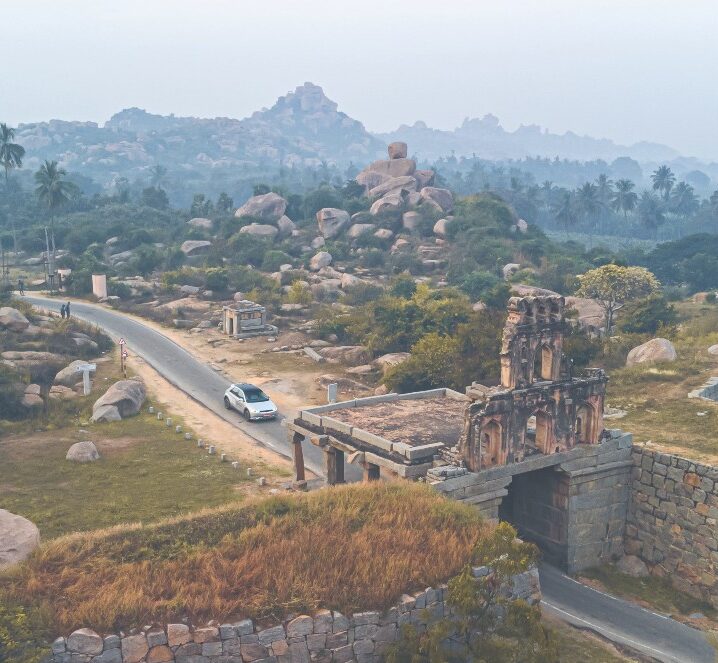 The drive to the temple was breathtaking itself, stretching across some beautiful roads and sights and scenes. Now that I’ve been driving through these narrow rural roads, I better understand the IONIQ 5’s everyday practicality and liveability for one’s daily use. Truth be told, I remain astonished at just how practical the IONIQ 5 proves to be.
The drive to the temple was breathtaking itself, stretching across some beautiful roads and sights and scenes. Now that I’ve been driving through these narrow rural roads, I better understand the IONIQ 5’s everyday practicality and liveability for one’s daily use. Truth be told, I remain astonished at just how practical the IONIQ 5 proves to be.
The IONIQ 5 can easily tackle most speed breakers and potholes thanks to the E-GMP platform. The turning radius may take some time, but that’s a minor hurdle. Even the overall visibility outside is quite good, and the ultra-clear surround cameras do a fantastic job showing you any and every obstacle with some excellent camera quality. The usable space inside the IONIQ 5 is quite commendable too. There is more than sufficient space inside the cabin and the cubby holes, but Hyundai adds to it by giving you a big enough boot capacity, and it even has a frunk! It’s a small frunk but sufficient to store your charging necessities and a couple of other knick-knacks. Sadly there is no spare, and instead, you get a puncture repair kit, and a tyre inflator tucked away in the boot. Fortunately, we didn’t have to use ours so far, but if it’s something you’ve never done, I suggest getting more up to speed with the whole process.
5,460KM – Udupi, Karnataka
Practicality out of the way, it was time to head to our next destination, which falls on the west coast of India and is the coastal city of Udupi. What’s at Udupi, you ask? Well, on the outskirts of Udupi lies a 57-foot-tall monolithic statue carved out of a single piece of granite. It is the statue of Bahubali, and a depiction of his meditation said to last long enough for vines to grow at his feet. It’s an excellent time to ponder various things we’ve noticed about the IONIQ 5.
For starters, the sound system on the IONIQ 5 is decent but not the best In its class. It falls short of the ones found on the Volvo XC40 Recharge, which is the best in its class. The ambient lighting on the IONIQ 5 is defused and does a good job illuminating this light-coloured cabin. A couple more features are rather clever in the IONIQ 5, like the ability to turn off the air conditioning for all the passengers and leave it on just for the driver.
This is a great way to conserve energy and maintain cooling. The prominent feature that Hyundai has been talking about is its V2L ability, which allows it to charge any electrical appliances or even power another EV in an emergency. A three-pin socket is embedded under the rear passenger seat, allowing you to charge your laptop on the go. In reality, it only works when you’re stationary, so that can be a bummer, but if you’re okay with working while waiting at the side of the road, then it’s a feature you’d appreciate.
However, I wonder if anyone will go camping with the IONIQ 5; the ones that’ll even take it out for a picnic will be quite a niche. Does this feature justify the hype around it? Well, sorta. Having this feature in your arsenal enables you to pursue more spontaneous endeavours and be more carefree about your devices. Though I highly doubt you’d be carrying anything more than a pair of speakers at best, and for that reason, I’ve got somewhat mixed feelings about this feature. It’s a cool gimmick, I’ll give it that, but to me, it’s not a very useful feature and would have made a lot more sense on an offroad vehicle than on a rear-wheel drive crossover.
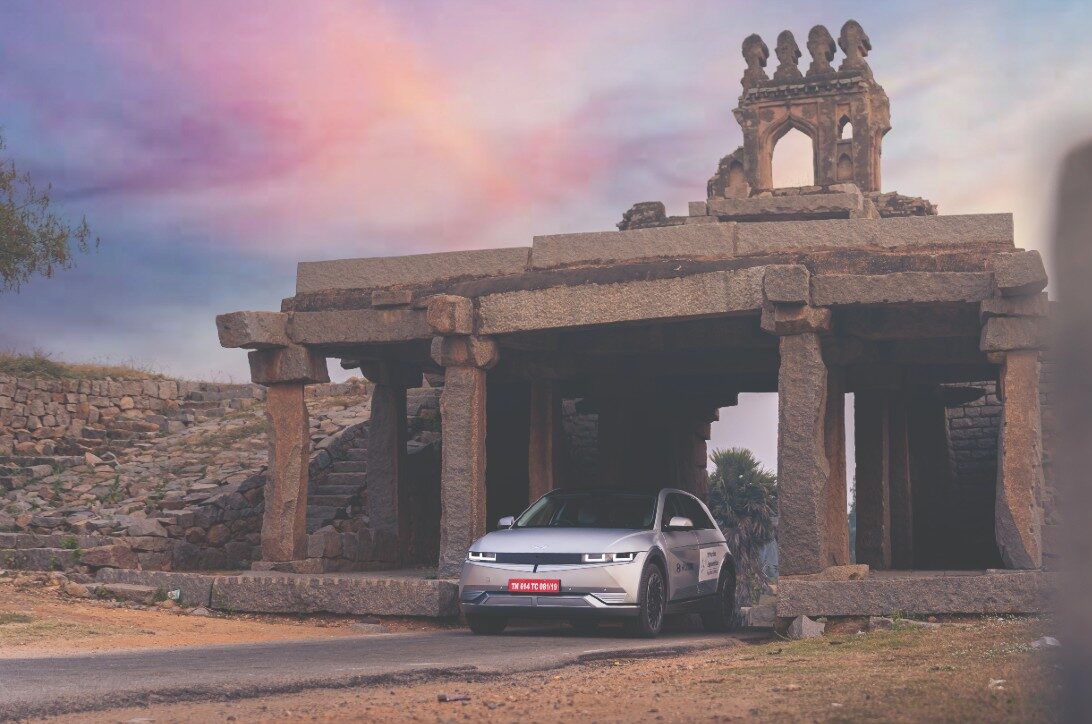
After enjoying the scenic coastal roads of Udupi, it was time we pushed for our final destination, Mumbai. It never felt so good to return home, sweet home; I especially missed the food and the familiarity of speaking a known language. Sadly it’ll also be where I’d have to part ways with the lovely IONIQ 5. It’s been a reliable steed and has worked effortlessly through anything and everything the road has presented. The longest stretch we could pull on one full charge was about 530 km, which is commendable for an EV as most ICE vehicles struggle to have a range over 450 kms. Plus, you’ve got to factor in the cost. The owner of an IONIQ 5 will spend a lot more on cleaning the seats than he’d actually spend charging the IONIQ 5.
At an ex-showroom price of Rs. 45 lakhs, the IONIQ 5 isn’t the most accessible EV out there, but it manages to undercut its competition while performing just as well, if not better, in some cases. Would I ever like to make a road trip this long in an EV? No. This was tedious, to say the least, and our infrastructure has a long way to go. However, if I ever have to set out on a road trip of this sort, I’d happily hop inside the IONIQ 5 as it’s most certainly a capable vehicle and quite reliable at that. What more could you want from your EV? And on that note, I must conclude this story.
6,300KM – Mumbai, Maharashtra
FOR – Dashing aesthetics, genuinely sustainable, great range
AGAINST – Intrusive driver aids, sensitive paint, limited interior and exterior shades.

